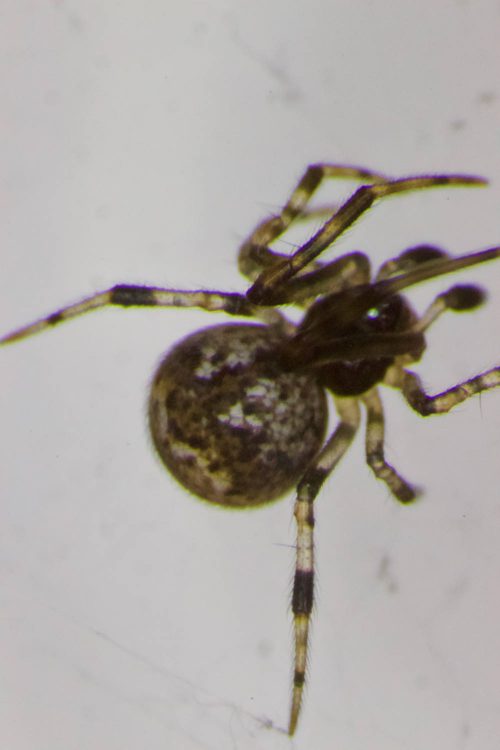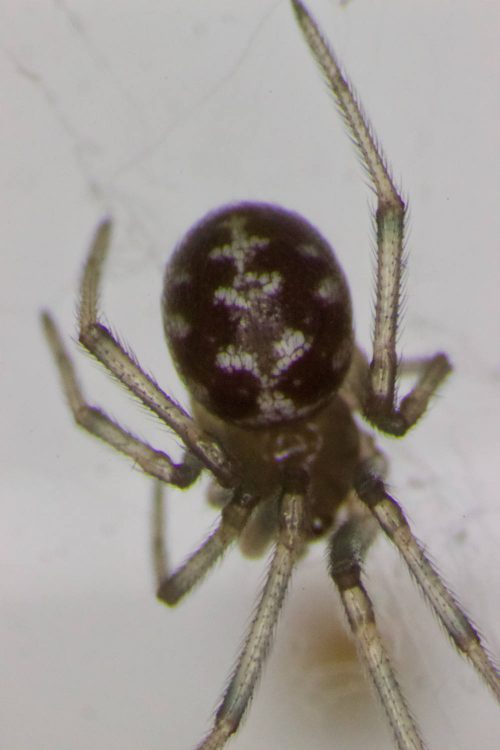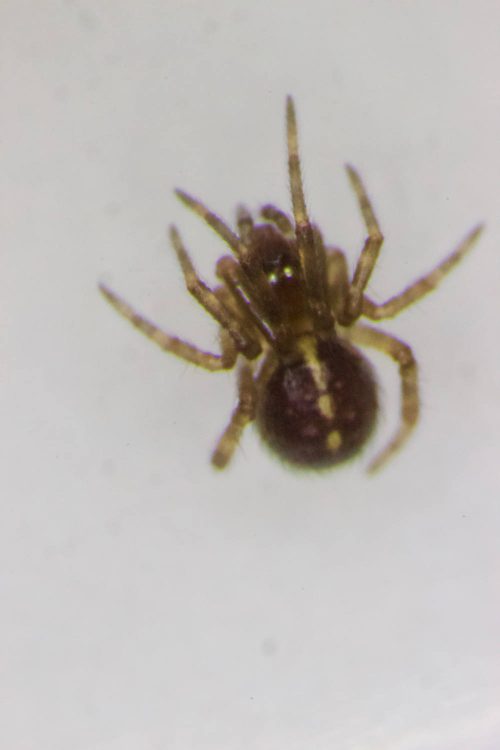I’ve been wrestlin’ spiderlings all day, although they’re getting big enough that they’re showing sexual characteristics, like enlarged palps in the males, so maybe they’re more like spider-teens. They’re about three weeks old — I showed you the newly emerged S. triangulosa a while back. I’m currently raising three species (maybe four) of Theridiidae, P. tepidariorum, S. triangulosa, and S. borealis, and I’m seeing that some of the patterns emerge fairly early and in predictable ways.
This is P. tepidariorum, the most common of these spiders, and the one I’m raising for experimental studies in the lab. Some of its obvious characteristics are the mottled abdomen — although it’s still specifically patterned, as you might see from the clear left/right symmetry — and the dark banding around the limb joints. Less obviously from the photo, one other feature is that they build 3-dimensional webs that take full advantage of the space they’re in. When I open up the container, they’re hanging suspended in the middle of the space.
By the way, I’m pretty sure that one’s a male — the palps are enlarged, but not to the extent they will be in the full adult.
While we were out collecting, we also encountered a few S. triangulosa, and I collected a few for curiosity’s sake. They’re pretty, too! They have a nice pattern on the abdomen, with those distinctive white patches that set off the darker zig-zags along the side. They lack the strong banding around their leg joints. Their webs are subtly different, too: all of them had made a sheet of silk near the bottom of their containers, and they’d hang upside down in them, putting the web between them and the open space.
Finally, here’s S. borealis. The adults are easily distinguished from the other species, because they’re a solid purplish black with sometimes a lighter horizontal line on the front half of the abdomen, and another light line on the midline of the anterior abdomen. It’s very stylish. Here you can see that white pigmentation clearly, but they have not uniformly darkened up every where else yet. They also lack the limb banding, and they’re also going to grow up to be larger than the other species.
Don’t sneer at the quality of the photos, I’m still trying to figure out how to get them to hold still. I know there are ways to generally anesthetize or immobilize arthropods, like by refrigerating them, but these are young’uns and breeding stock, so I’m reluctant to do anything that might risk their viability. I had a grand time putting them under the scope and poking them with a brush to get them to change orientation — of course they prefer to hang upside down, but I want to get a look at the dorsal abdomen — and then I have to chase them on the stage and tweak the focus and snap a picture. At least this time I had a remote trigger that I could hold in my focusing hand so it was a little easier to get photos than the last time.
It’s got to get easier still, though. This winter, I want to raise spiderlings matched by day of emergence from the egg sac from all three species, and get sharp photos of dorsal abdominal pigments at regular intervals to get a time-course of their formation. Patterns are just one of those things that get developmental biologists worked up, you know. Also, P. tepidariorum shows more individual variation in those patterns, so it would be nice to get a genetic handle on their regulation. That and the other dozen projects I have in mind will keep me out of trouble when the snows come.





I’m wondering if you could make some sort of “plate” to hold the spiders specifically for photography, maybe something like two sheets of plexiglass about a ~1/4″ apart, with some sliding barriers, so you could confine the spider to an area small enough that it can’t turn around or turn over, and then photo it from either side as needed.
Probably too much work for the effort, and that isn’t even taking into consideration unforeseen complications and such.
Also, the photos you’ve been posting seem to be turning out pretty well, so…
I’ve done that for zebrafish embryos, but those embryos don’t go skittering away to get squashed by the coverslip.
Perhaps you could use the two plate idea but with a “web” of loose filaments that would inhibit motion.
I know other commenters have wondered about imaging outside the visible spectrum, to which I’ll add my own curiosity about UV fluorescence, which is on the cheaper end of that sort of thing (up to a point).
It also wonders me out loud if there’s a flat surface spiders have a preference for that you put them on and then hang them upside down over a scanner, or maybe that’s more problematic than using a camera…
… I like the idea of filamentous surface –maybe pulled cotton or some such.
A slightly tacky surface might make them a little less quick to skedaddle…
sort of on topic now so I’m reposting.
https://www.theguardian.com/fashion/2019/sep/24/say-it-with-a-brooch-how-a-fashion-item-became-a-political-statement
I’m not sure the body configuration is quite right but there are an awful lot of different spiders.
OK, I have another question for the arachnologist: Do orb spiders have a preferred side of the web? As I said the other day, I’ve got an orb spider that has built a web right outside my front door. A huge web (about 4 feet by 4 feet). And I presume that they tend to pick a side when they do that gathering of the strands in the center (I am presuming to manage the tension in those spokes) and since getting to the other side would require going to the edge of the web and climbing over, they tend to stick to one side, but do they have a preference? The side facing toward the sun? Away from the sun? Wind directions? Is it random? The one outside my door is on the side toward the door.
And given that any insect flying into the web becomes a 3-D intruder on what is essentially a 2-D surface, it doesn’t really matter which side the spider is on because they’ll just pull it through the big hole in the web the thing made when it got stuck, but I’m wondering if there is something in spider behaviour that is involved.
rrhain @ 7
really not a spider person, so probably not the person to listen to, but from what I’ve seen of orb and… other? webs, I feel like a lot of spiders like to be on the opposite side of the web as their prey? I’m assuming it’s so they can approach their snared prey with less worries about being kicked/wingstruck/stung/whatever, and still have easy access to soft parts to sink their fangs into and digest/subdue them.
But I’m going to be checking in to see what the more knowledgeable sorts say…
I think PZ refers more to something like this: https://www.researchgate.net/publication/8666058_Evolution_and_ecology_of_spider_coloration
Following this process with interest, having never actually made it into any lab, let alone a biological one.
I know that when studying zebrafish you’re using lab specimens with a particularly narrow genetic profile. Are you always thinking in the back of your mind that you’re in the early stages of the process of creating something similar from the wild strain spiders? I’m curious as to how that process affects the things you’re hoping to learn.
S. borealis is pretty.
@2 PZ
Have you tried electric and/or magnetic fields?
jack16